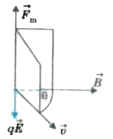Consider a charged particle moving with constant velocity inside a region of space where electric and magnetic field both are present. How can the fields and velocity be directed to achieve this state?
Let us assume it as one positive charge and for the negative charge, directions of fields will be + just opposite. Electric field applies force on the positive charge in its direction. And direction of magnetic force is governed by right hand rule as described in →F=q→v×→B To make net force zero we require →v×→B opposite to →E . We know that the direction of cross product is always perpendicular to the common plane of those two vectors in cross product. So we can say that both →vand →B must be perpendicular to →E. You can now visualise the whole situation as follows: Draw a plane perpendicular to electric field intensity vector. Velocity vector and magnetic field R V intensity vector both must lie on this plane. Angle between velocity vector and magnetic field intensity vector can be other than 90∘ also. Let this angle be θ. Now orientation of velocity vector and magnetic field intensity vector on this plane must be such that cross product is antiparallel to electric field, which is already perpendicular to this plane.
For net force to become zero, we can write as follows:
qE=qvBsinθ⇒E=Bvsinθ
if angle θ=90∘, then E=Bv.

Topper's Solved these Questions
- MOVING CHARGES AND MAGNETISMBOOK - MODERN PUBLICATIONCHAPTER - MOVING CHARGES AND MAGNETISMEXERCISE - Tough & Tricky (PROBLEMS )
15 Videos
- MOVING CHARGES AND MAGNETISMBOOK - MODERN PUBLICATIONCHAPTER - MOVING CHARGES AND MAGNETISMEXERCISE - NCERT FILE (NCERT Textbook Exercises)
13 Videos
- MOVING CHARGES AND MAGNETISMBOOK - MODERN PUBLICATIONCHAPTER - MOVING CHARGES AND MAGNETISMEXERCISE - PRACTICE PROBLEMS
59 Videos
- MAGNETISM AND MATTERBOOK - MODERN PUBLICATIONCHAPTER - MAGNETISM AND MATTEREXERCISE - CHAPTER PRACTICE TEST FOR BOARD EXAMINATION
16 Videos
- NUCLEIBOOK - MODERN PUBLICATIONCHAPTER - NUCLEIEXERCISE - CHAPTER PRACTICE TEST FOR BOARD EXAMINATION
15 Videos
Similar Questions
A charge particle travels along a straight line with a speed v in region where both electric field E and magnetic field b are present.It follows that
View SolutionA charged particle moving with a uniform velocity →v enters a region where uniform electric and magnetic fields →E and →B are present. It passes through the region without any change in its velocity. What can we conclude about the (i) relative direction of →E, →V and →B? (ii) magnetic of →E and →B?
or
Find the condition under which the charged particle moving with different speeds in the presence of electric and magnetic field vectors can be used to select charged particles of a particular speeds.
View Solution
Knowledge Check
A charged particle is moving with velocity Vin magnetic field
AIts momentum changes but total energy remains sameBboth momentum and total energy remains sameCboth momentum and total energy changeDtotal energy changes but momentum remains the sameA charge particle travels along a straight line with a speed v in region where both electric field E and magnetic field b are present.It follows that
A|E|=|B| and the two field are perpendicularB|E|=v|B| and the two field are perpendicularC|B|=v|E| and the two field are parallelD|B|=v|E| and the two fields are perpendicularA charged particle moving with velocity vis subjected to electric field E and magnetic field B. The particle will go undeflected if
AE is perpendicular to B.BE is parallel to v and perpendicular to B.CE and B both are parallel to v.DE, B and v are mutually perpendicular but v=EB.
A particle having charge q moves with a velocity v through a region in which both an electric field →E and a magnetic field B are present. The force on the particle is
View SolutionForce acting on a moving charged particle in a region of electric and magnetic fields is called
View SolutionThe force on a charged particle moving with a velocity →v in a magnetic field →B is :
View SolutionThe force on a charged particle moving with a velocity →v in a magnetic field →B is :
View SolutionAn electric charge q is moving with a velocity w in the direction of a magnetic field B. The magnetic force acting on the charge is
View Solution
